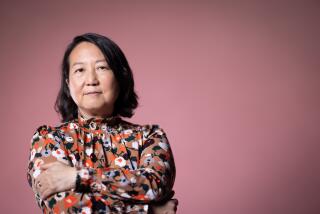The Freedom Fighter : Lawyer Julie Su Finds Inspiration in the Thai Garment Workers She’s Assisting
- Share via
It is with nostalgia that Julie Su recalls her only arrest back in 1989.
As a leader of Stanford University’s Asian American Students’ Assn., she and other minority classmates were detained briefly by police after a peaceful sit-in protesting racism on campus.
“Well, I was arrested, but, you know, well, in the end, all the charges were dropped.”
No convictions then?
“Ah, no, I’m afraid not.”
So much for the secret life of Los Angeles’ most celebrated, young, non-O.J. lawyer.
Julie Ann Su, age 26, Phi Beta Kappa , Stanford; cum laude , Harvard Law; daughter of Chinese immigrants; defender of underdogs; accomplished tap dancer.
Three weeks ago, as cameras clicked and whirred, Su led the first of 72 Thai garment workers to freedom after their rescue from an El Monte sweatshop and subsequent detention by the U.S. Immigration and Naturalization Service. She was foremost among lawyers who had negotiated the workers’ release on bond and found housing and jobs for them.
Since then, Su has led many of the workers to the beach, Griffith Park and Disneyland. And, in the process, she has become more than their friend. Among the coalition of activists and public-interest lawyers representing the 72 undocumented workers, she has been the most visible and outspoken advocate for the immigrants’ cause.
“The story of Julie Su is really not that interesting,” she insists. “The story of these immigrant workers--how they came here with their dreams of America, how they were enslaved, how they were freed only to be incarcerated again--that’s the story that needs to be told.”
But, at least recently, the story of Julie Su is the story of the Thai garment workers. As a $32,500-per-year attorney for the Asian Pacific American Legal Center, Su has been working seven days a week to help the laborers--taking them to lunch, taking them to the dentist and taking them to court to tell their own stories.
Today Su will observe Labor Day by joining a march through Chinatown to protest the exploitation of immigrant workers and honor the sacrifices of her clients. “They are victims of some of the worst crimes imaginable,” she says.
Most of the laborers are rural women who left impoverished eastern Thailand and enlisted in the Bangkok sewing trade. Their employers brought them to the United States, telling the workers the debt for their transportation--almost $5,000 per person--would be subtracted from their earnings. Nine defendants have been charged with harboring and transporting illegal immigrants.
Virtually imprisoned behind barbed wire in a guarded El Monte complex, the workers were forced to toil from 7 a.m. to midnight for less than $2 per hour for years, according to state and local authorities who raided the operation last month.
In a cramped office on the fourth floor of the United Methodist Church building at the corner of Flower Street and Olympic Boulevard, Su also toils long hours. When she takes a break, it is to join the Thai workers at a Buddhist temple or a picnic or a park.
Every encounter she describes as “awesome.”
“Can you imagine not seeing the sky for years? On our very first outing, one of the workers said to me, ‘This is my new birthday. I feel I have been born again.’
“A woman on our visit to Griffith Park Observatory looked down at Los Angeles and said, ‘This looks like heaven.’
“They are so inspirational to me. They are such gentle, good-hearted people. And they really want to get back to work. This flies in the face of everything [Gov.] Pete Wilson says. All they’ve ever done since they came to this country is be productive.
“They truly are heroes.”
Educated at elite educational institutions such as Stanford and Harvard was a privilege, says Su, but one that exposed in stark detail the differences between the haves and have-nots in the United States.
“Stanford, for example, was built by indentured Chinese railroad workers. Nobody ever talks about that,” rages Su, who, after a tour with the Peace Corps in Belize, found other reasons to be outraged when she began law school at Harvard.
There, as at Stanford, she agitated and organized and engaged in civil disobedience to promote more curricular attention to matters of social justice.
“At Harvard, we learned to think like lawyers, but we did not learn to think like human beings,” she says. “In fact, these were mutually exclusive.”
Over the last month, she says, life’s lessons have been more relevant. “I’ve learned some phrases in Thai--how to say ‘I’ve missed you,’ ‘I’ve been thinking about you,’ and how to say, ‘This is a good person, a warm-hearted person.’ ”
Each night, Su returns to her parents’ home in Cerritos, where she shares a flowery bedroom with her younger sister. Her modest salary for working at the legal center is paid by the Skadden Fellowship--a grant from the New York law firm Skadden, Arps, Slate, Meagher & Flom that pays young lawyers to work in public interest law. The condition of Su’s fellowship is that she litigate on behalf of workers to eliminate sweatshop conditions in Southern California.
As a child, Su knew little about the rights of indigent workers, but she did know something about immigrants. Her parents, who owned a laundermat when Su was young, were Chinese immigrants and no strangers to racial discrimination.
“There were times when I knew we were being demeaned or ridiculed. There were the neighbors who’d run into the yard and pull their eyes back into slits like a cartoon. There were the people who made fun of the way my parents spoke English.”
Tody Su is fluent in Mandarin and speaks “passable” Spanish. “Access to power, to rights in this country can have much to do with language,” says Su. “As a lawyer, I have tremendous power--power that can be used to achieve social justice. It is a great responsibility.”
But, for all her efforts, there are also great rewards.
Last week, in the warm sand next to the Santa Monica pier, a few of the Thai laborers taught her some of their country’s dances.
“I’m a lot better at tap dancing, but still it was--awesome.”
More to Read
Sign up for Essential California
The most important California stories and recommendations in your inbox every morning.
You may occasionally receive promotional content from the Los Angeles Times.










